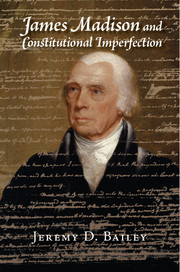Book contents
- Frontmatter
- Dedication
- Contents
- Preface
- Acknowledgments
- Abbreviations
- 1 The Madison Problem
- 2 Appeals to Tradition: The Case for and against Veneration
- 3 Appeals to Elites: The Problem with Deliberation
- 4 Public Opinion before Parties
- 5 The Turn to Public Opinion
- 6 Appeals to the People: Madison and the Revolution of 1800
- 7 Appeals to Text and History
- 8 “Take care of me when dead”
- Index
Preface
Published online by Cambridge University Press: 05 November 2015
- Frontmatter
- Dedication
- Contents
- Preface
- Acknowledgments
- Abbreviations
- 1 The Madison Problem
- 2 Appeals to Tradition: The Case for and against Veneration
- 3 Appeals to Elites: The Problem with Deliberation
- 4 Public Opinion before Parties
- 5 The Turn to Public Opinion
- 6 Appeals to the People: Madison and the Revolution of 1800
- 7 Appeals to Text and History
- 8 “Take care of me when dead”
- Index
Summary
This book's cover includes a photograph of James Madison's letter to John G. Jackson, written in 1821. In that letter, clearly revised with care, Madison made an extraordinary confession to Jackson. He confessed that some of the delegates to the Federal Convention of 1787 had been overly influenced by Shays’ Rebellion in Massachusetts. By overestimating the importance of that rebellion, these delegates imparted a “higher toned system than was perhaps warranted.”
This confession should surprise readers who are familiar with Madison's political thought and with the history of the early republic. It is not surprising because an important American Founder said it. After all, Madison's friend and lifelong accomplice made that point over and over again as soon as the text of the new Constitution reached him in France. To Madison, Thomas Jefferson wrote, “The late rebellion in Massachusetts has given more alarm than I think it should have done.” Jefferson was more descriptive to William S. Smith: “Our Convention has been too much impressed by the insurrection of Massachusetts: and in the spur of the moment they are setting up a kite to keep the hen-yard in order.” It is surprising because, according to our accepted understandings of Madison, Shays’ Rebellion represents the critical difference between him and Jefferson.
In what follows, I argue for a new reading of Madison, and this new reading emphasizes the alliance between Madison and Jefferson. In this, I have followed the path blazed by Lance Banning. I do not, however, agree with all of Banning's conclusions. Most importantly, I do not share Banning's central assumption that, for Madison, republicanism presupposed a particular variety of federalism. I think Banning's otherwise definitive account is distorted on that point, and readers will see that I am not all that interested in determining the extent to which Madison was a nationalist.
- Type
- Chapter
- Information
- James Madison and Constitutional Imperfection , pp. ix - xPublisher: Cambridge University PressPrint publication year: 2015



